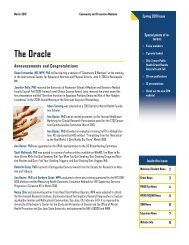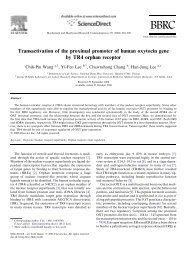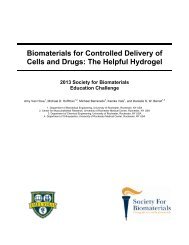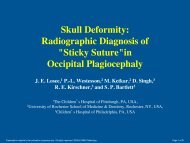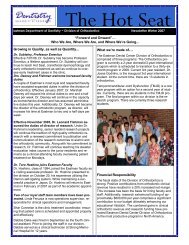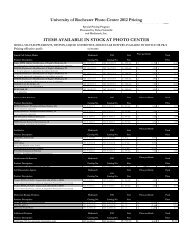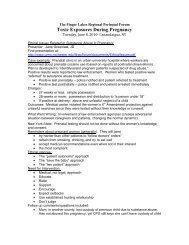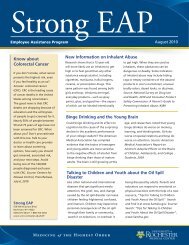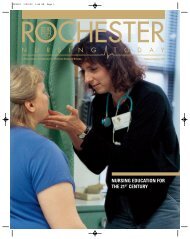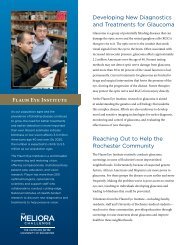Fall/Winter 2006 - University of Rochester Medical Center
Fall/Winter 2006 - University of Rochester Medical Center
Fall/Winter 2006 - University of Rochester Medical Center
Create successful ePaper yourself
Turn your PDF publications into a flip-book with our unique Google optimized e-Paper software.
discussed disease prevention and the illusion<br />
<strong>of</strong> immortality. The panel, a collection <strong>of</strong> stars<br />
in their field put together by the American<br />
Health Foundation, also included heart<br />
surgeon Michael De Bakey, M.D., psychoanalyst<br />
Rollo May, anthropologist Ashley<br />
Montagu and activist clergyman the Rev.<br />
William Sloane C<strong>of</strong>fin Jr.<br />
In 1990, Dr. Berg headed an Institute<br />
<strong>of</strong> Medicine committee that issued a report<br />
called “The Second 50 Years,” which found<br />
many <strong>of</strong> the disabilities <strong>of</strong> the elderly are<br />
preventable and criticized doctors and public<br />
health experts for writing <strong>of</strong>f the older generation<br />
as being beyond help.<br />
Bradford C. Berk, M.D., Ph.D., the<br />
<strong>University</strong>’s senior vice president for health<br />
sciences and chief executive <strong>of</strong>ficer <strong>of</strong> the<br />
<strong>Medical</strong> <strong>Center</strong>, said: “Bob Berg had broad<br />
knowledge and vision, and a kindness about<br />
sharing those gifts that made him a role<br />
model for everyone from primary care physicians<br />
to physician-scientists to geriatricians,<br />
and to me personally.”<br />
Dr. Berg’s wife, Florence Berg, died<br />
in 1985. He is survived by a daughter, Astri<br />
Cornett <strong>of</strong> Boxborough, Mass., and a son,<br />
Erik C. Berg <strong>of</strong> Boise, Idaho, five grandchildren<br />
and two great-grandchildren.<br />
Contributions can be made to the Florence<br />
and Bob Berg Fund at the <strong>University</strong> <strong>of</strong><br />
<strong>Rochester</strong>’s Memorial Art Gallery or the<br />
Bob Berg Endowed Fund in Community and<br />
Preventive Medicine. Send contributions<br />
to the <strong>University</strong> Advancement Office, Box<br />
270032, <strong>Rochester</strong>, NY 14627–0032.<br />
Robert B. Duthie<br />
Robert Buchan Duthie, a former chairman <strong>of</strong><br />
the Division <strong>of</strong> Orthopaedic Surgery at the<br />
<strong>University</strong> <strong>of</strong> <strong>Rochester</strong> <strong>Medical</strong> <strong>Center</strong>, died<br />
Dec. 25 in England. He was 80.<br />
Pr<strong>of</strong>essor Duthie served as a pr<strong>of</strong>essor<br />
and division chairman in <strong>Rochester</strong> from 1958<br />
until 1966, when he became the 14th Nuffield<br />
Pr<strong>of</strong>essor <strong>of</strong> Orthopaedic Surgery at the<br />
<strong>University</strong> <strong>of</strong> Oxford in England, with a<br />
pr<strong>of</strong>essorial fellowship at Worcester College.<br />
In an obituary, The Journal <strong>of</strong> Bone &<br />
Joint Surgery called Pr<strong>of</strong>essor Duthie “an<br />
internationally renowned figure in academic<br />
orthopaedic surgery who developed the<br />
Nuffield Orthopaedic Centre and Accident<br />
Service in Oxford into one <strong>of</strong> the leading<br />
musculoskeletal centres in the world.”<br />
At Oxford, Pr<strong>of</strong>essor Duthie established<br />
collaborative clinical and research units in the<br />
treatment <strong>of</strong> hemophilia, arthritis, metabolic<br />
bone disease and bioengineering. He initiated<br />
and supported work in artificial limbs and the<br />
study <strong>of</strong> the causes and prevention <strong>of</strong> traffic<br />
accidents. His textbook on hemophilia is<br />
described as a classic. Through his work as<br />
editor, Mercer’s Orthopaedic Surgery was<br />
recognized as the leading English text.<br />
C. McCollister “Mac” Evarts, M.D.<br />
(M ’57, R ’64), one <strong>of</strong> the residents selected by<br />
Pr<strong>of</strong>essor Duthie during his time at <strong>Rochester</strong>,<br />
described him as one <strong>of</strong> the most respected<br />
teachers and leaders participating in organizing<br />
the orthopaedics division and setting<br />
new directions for the institution.<br />
“He demanded excellence from those<br />
who surrounded him, but no more than he<br />
demanded <strong>of</strong> himself,” Evarts said. “He<br />
brought precision into the surgical theater,<br />
the education <strong>of</strong> students and residents,<br />
research efforts and within policy making<br />
committees.”<br />
Pr<strong>of</strong>essor Duthie was born in Detroit,<br />
the son <strong>of</strong> an engineer who worked for Henry<br />
Ford. But he received his undergraduate and<br />
medical education at the <strong>University</strong> <strong>of</strong><br />
Edinburgh in Scotland. His many honors<br />
include being named a commander in the<br />
Order <strong>of</strong> the British Empire.<br />
Joan Wright Goodman<br />
By David Perlman<br />
San Francisco Chronicle Science Editor<br />
Joan Wright Goodman (PhD ’52), a pioneering<br />
stem cell researcher, physiologist and tireless<br />
advocate for the role <strong>of</strong> women in science,<br />
died <strong>of</strong> respiratory failure after a long illness<br />
at the Kaiser Hospital in Oakland, Calif., July<br />
10. She was 81.<br />
A woman noted for her energy and<br />
enthusiasm, Dr. Goodman entered law school<br />
at the <strong>University</strong> <strong>of</strong> San Francisco after she<br />
retired in 1985 from her long career as a<br />
scientist — first at the Oak Ridge National<br />
Laboratory in Tennessee and later at<br />
<strong>University</strong> <strong>of</strong> California’s Lawrence Berkeley<br />
National Laboratory. Upon graduation from<br />
law school, she was admitted to the bar.<br />
Dr. Goodman decided not to practice<br />
law and instead became a dedicated patron<br />
<strong>of</strong> San Francisco’s ballet, opera, music and<br />
film communities.<br />
Her scientific work earned her a major<br />
reputation as the first scientist to demonstrate<br />
that stem cells from bone marrow<br />
circulated in the peripheral blood <strong>of</strong> mammals<br />
— work that has been repeatedly cited in<br />
scientific journals and remains basic to stem<br />
cell research today, according to Charles<br />
Congdon, M.D., a physician and cancer<br />
researcher at Oak Ridge who was Dr.<br />
Goodman’s longtime colleague there.<br />
“Jodie’s work was really remarkable,”<br />
Congdon said. “She was an informal leader<br />
with a great deal <strong>of</strong> influence on her<br />
colleagues, and at many national and international<br />
meetings she shared the results <strong>of</strong> her<br />
work with clinicians who were treating<br />
patients.”<br />
Although Dr. Goodman was working in<br />
the lab with great success, Congdon said, she<br />
was well aware that it was tough for most<br />
women to advance as scientists.<br />
“In those days, women in science were<br />
not given much consideration,” he said, “but<br />
Jodie kept reminding us all that women could<br />
do as well as men. She was really outspoken<br />
about that inequity in science, and she had a<br />
great influence on us all, including me.”<br />
Dr. Goodman and her Oak Ridge<br />
colleagues also were distinguished for their<br />
research contributions to the study <strong>of</strong> bone<br />
FALL / WINTER <strong>2006</strong><br />
65



